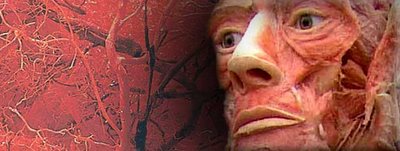
So very, very cool ... but to some may seem quite strange, quite quirky, quite gross. For others, quite impressive, sci-fi and indefinate. What is it .... the best way to describe it is to take the info from the Plastination History site: (P.S. Thre is an Anatomical Exhibition going on called Body Worlds 2)
In July 1977, while working as a scientist and research assistant at the University of Heidelberg’s Institute of Pathology and Anatomy, Dr. Gunther von Hagens had an outrageous notion. "I was looking at a collection of specimens embedded in plastic. It was the most advanced preservation technique then, where the specimens rested deep inside a transparent plastic block. I wondered why the plastic was poured and then cured around the specimens, rather than pushed into the cells, which would stabilize the specimens from within and literally allow you to grasp it."
The notion was an epiphany for Dr. von Hagens, and the genesis of Plastination — his groundbreaking invention where all bodily fluids and soluble fat from anatomical specimens are extracted to stop decomposition, and replaced through vacuum-forced impregnation with reactive resins and elastomers, such as silicon rubber and epoxy that harden with gas, light, or heat curing, giving the specimens rigidity and permanence.
Weeks later, while preparing serial slices of human kidneys for a research project, another thought occurred to him as he embedded the kidney slices in liquid plexiglass, and watched the air bubbles that resulted from stirring the hardener that had to be extracted under vacuum. "It crossed my mind that it would be possible to impregnate an acetone soaked renal piece with plastic under vacuum conditions simply by extracting the acetone in the form of bubbles, just as is done in degassing." Though many acetone bubbles were extracted from the specimen, it shriveled into a black mass within the hour.
But Dr. von Hagens was undeterred by the result of his maiden voyage into the world of Plastination. His basic knowledge of physics and chemistry enabled him to conclude that the black coloration stemmed from the refractive qualities of the impregnation process. This realization prompted him to repeat the experiment a week later using liquid silicone rubber that had more favorable light refractive properties. He administered the impregnation slowly, pouring fresh silicon in three separate baths to avoid premature hardening of the silicon and specimen from exposure to air. After curing the specimen in the open air, Dr. von Hagens held in his hands the world’s first plastinate.
In March of 1978, Dr. von Hagens filed a patent for his invention with the German Patent Office. However, he had only scratched the surface of Plastination. The refinement of his invention and the creation of the first whole body plastinate would take thirteen more years, though he declares even now that his methods are not yet perfect.
As they say ..... "REST IN PLASTIC"






No comments:
Post a Comment